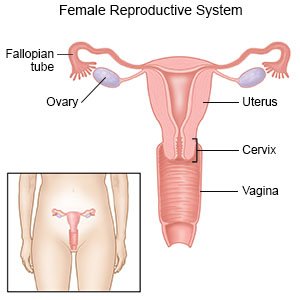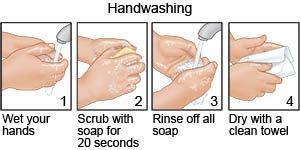Vaginal Foreign Body in Children
Medically reviewed by Drugs.com. Last updated on Aug 4, 2025.
What is a vaginal foreign body?
A vaginal foreign body is an object that gets stuck in your child's vagina. Some examples are wadded toilet paper, toys, and crayons.
 |
What are the signs and symptoms of a vaginal foreign body?
Signs and symptoms depend on the type of foreign body and how long it is in place:
- Pelvic pain or discomfort
- Discharge from your child's vagina that may smell foul or be pink or brown
- Vaginal bleeding in younger children or vaginal bleeding that is not your older child's monthly period
- Changes or problems with urinating or having bowel movements
- Urinary tract infections that happen often
How is a vaginal foreign body found and removed?
Your child's healthcare provider will ask about your child's symptoms and when they began. Tell the provider if you know what the foreign body is and how long it has been there. Your younger child may need general anesthesia before some tests or procedures. Your older child may want you or another trusted adult in the room during tests or procedures. Your child's provider may use any of the following, depending on your child's age:
- X-ray, CT scan, MRI, or ultrasound pictures may be used to find the object. Your child may be given contrast liquid to help the object show up better in pictures. Tell the healthcare provider if your child has ever had an allergic reaction to contrast liquid. Do not let your child enter the MRI room with anything metal. Metal can cause serious injury. Tell the provider about any metal in or on your child's body.
- Vaginoscopy may be used to help your healthcare provider find or remove the object. A small scope with a light and camera is placed into the vagina.
- A pelvic exam may be done if your child is an older adolescent. During a pelvic exam, a speculum is gently placed into the vagina. A speculum is a tool that opens the vagina. Your child's provider may remove the object with forceps. Samples of any vaginal discharge will be sent to a lab for tests.
- Surgery may be needed if your child's provider is not able to remove the object another way.
What can I do to help my child manage a vaginal foreign body?
The following may help relieve symptoms from the vaginal foreign body or from procedures used to remove it:
- Give medicines as directed to prevent or relieve symptoms. Antibiotics may be given to help prevent or fight a bacterial infection. Hormone cream may heal scratches or wounds in your child's vagina. Over-the-counter creams or ointments help decrease itching and inflammation. Examples include petroleum jelly, zinc creams, or hydrocortisone creams.
- Have your child use a sitz bath. Fill a bathtub with 4 to 6 inches of warm water. You may also use a sitz bath pan that fits inside a toilet bowl. Have your child sit in the sitz bath for 15 minutes each day, or as directed. The warm water may help decrease pain and swelling.
- Tell your child not to use douches other products that may irritate the vagina. Examples include bubble baths and perfumed soaps. The vagina is delicate and easily irritated. Ask if it is okay for your child to use tampons during monthly periods. Your child may need to use pads instead until the symptoms go away.
How can I help my child prevent an infection?
- Teach your child proper handwashing. Teach your child to use soap and water. Your child needs to wash before preparing or eating food, and after using the bathroom. Older children may use an alcohol-based hand sanitizer if soap and water are not available.

- Teach your child to wipe from front to back. Your child needs to do this after urinating or having a bowel movement. This will help prevent germs from getting into the vagina.
- Keep your child's genital area clean. Wash the area around your younger child's vagina each day. Use mild, unscented soap. Let the area air dry before your child gets dressed. Teach your older child how to keep the area clean.
- Tell your child not to leave tampons in for longer than recommended. A tampon should never stay in the vagina for longer than 8 hours.
When should I call my child's doctor or gynecologist?
- Your child has a fever or chills.
- Your child's symptoms do not go away in 3 to 5 days.
- Your child has abdominal pain and cramps.
- Your child has pain in the lower back or side.
- Your child's skin is red, itchy, or has a new rash.
- Your child has a hard time urinating or urinates more often than usual.
- You think your child was sexually abused.
- You have questions or concerns about your child's condition or care.
Care Agreement
You have the right to help plan your child's care. Learn about your child's health condition and how it may be treated. Discuss treatment options with your child's healthcare providers to decide what care you want for your child. The above information is an educational aid only. It is not intended as medical advice for individual conditions or treatments. Talk to your doctor, nurse or pharmacist before following any medical regimen to see if it is safe and effective for you.© Copyright Merative 2025 Information is for End User's use only and may not be sold, redistributed or otherwise used for commercial purposes.
Further information
Always consult your healthcare provider to ensure the information displayed on this page applies to your personal circumstances.
